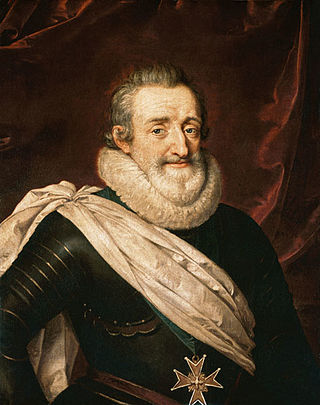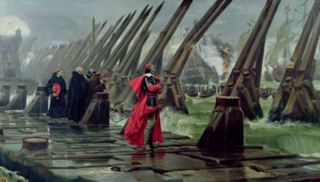External links
| | This French history–related article is a stub. You can help Wikipedia by expanding it. |
| | This article about something in the French city of Montpellier is a stub. You can help Wikipedia by expanding it. |
The Treaty of Montpellier (or the Peace of Montpellier) was signed in Montpellier on 18 October 1622 between King Louis XIII of France and Duke Henry II of Rohan. The treaty followed the siege of Montpellier and ended hostilities between French royalists and the Huguenots. Moreover, it confirmed the tenets of the Edict of Nantes, pardoned Henry II, and allowed the Huguenots to maintain their numerous forts and garrisons.

The Edict of Nantes was signed on 13 April 1598 by King Henry IV and granted the minority Calvinist Protestants of France, also known as Huguenots, substantial rights in the nation, which was predominantly Catholic.

Louis XIII was King of France from 1610 until his death in 1643 and King of Navarre from 1610 to 1620, when the crown of Navarre was merged with the French crown.

The French Wars of Religion is the term which is used in reference to a period of civil war between French Catholics and Protestants, commonly called Huguenots, which lasted from 1562 to 1598. According to estimates, between two and four million people died from violence, famine or diseases which were directly caused by the conflict; additionally, the conflict severely damaged the power of the French monarchy. The fighting ended in 1598 when Henry of Navarre, who had converted to Catholicism in 1593, was proclaimed Henry IV of France and issued the Edict of Nantes, which granted substantial rights and freedoms to the Huguenots. However, Catholics continued to have a hostile opinion of Protestants in general and of Henry, and his assassination in 1610 triggered a fresh round of Huguenot rebellions in the 1620s.

The siege of La Rochelle was a result of a war between the French royal forces of Louis XIII of France and the Huguenots of La Rochelle in 1627–28. The siege marked the height of the struggle between the Catholics and the Protestants in France, and ended with a complete victory for King Louis XIII and the Catholics.

François de Bonne, duc de Lesdiguières was a French soldier of the French Wars of Religion and Constable of France, and one of only six Marshals to have been promoted Marshal General of France.
The Treaty of Loudun was signed on 3 May 1616 in Loudun, France, and ended the war that originally began as a power struggle between queen mother Marie de Medici's favorite Concino Concini and Henry II de Condé, the next in line for Louis XIII's throne. The war gained religious undertones when rebellious Huguenot princes joined Condé's revolt.

The Citadel of Montpellier is an Early Modern fortification in the city of Montpellier, in the Hérault département of southern France. It was built between 1624 and 1627, after several rebellions under the orders of Louis XIII in order to keep watch over the town. In the 20th century it became the Joffre Barracks, named after Joseph Joffre, and since 1947 the citadel has been an academic campus – the nationwide famous Lycée Joffre.

The Recovery of Ré Island was accomplished by the army of Louis XIII in September 1625, against the troops of the Protestant admiral Soubise and the Huguenot forces of La Rochelle, who had been occupying the Island of Ré since February 1625 as part of the Huguenot rebellions.

The Naval battle of Saint-Martin-de-Ré took place on 27 October 1622, between the Huguenot fleet of La Rochelle under Jean Guiton, and a Royal fleet under Charles de Guise.

The Huguenot rebellions, sometimes called the Rohan Wars after the Huguenot leader Henri de Rohan, were a series of rebellions of the 1620s in which French Calvinist Protestants (Huguenots), mainly located in southwestern France, revolted against royal authority. The uprising occurred a decade after the death of Henry IV who, himself originally a Huguenot before converting to Catholicism, had protected Protestants through the Edict of Nantes. His successor Louis XIII, under the regency of his Italian Catholic mother Marie de' Medici, became more intolerant of Protestantism. The Huguenots tried to respond by defending themselves, establishing independent political and military structures, establishing diplomatic contacts with foreign powers, and openly revolting against central power. The Huguenot rebellions came after two decades of internal peace under Henry IV, following the intermittent French Wars of Religion of 1562–1598.

The siege of Saint-Jean-d'Angély was a siege, accomplished by the young French king Louis XIII in 1621, against the Protestant stronghold of Saint-Jean-d'Angély led by Rohan's brother Benjamin de Rohan, duc de Soubise. Saint-Jean-d'Angély was a strategic city controlling the approach to the Huguenot stronghold of La Rochelle.

The siege of Montauban was a siege conducted by the young French king Louis XIII from August to November 1621, against the Protestant stronghold of Montauban. This siege followed the siege of Saint-Jean-d'Angély, in which Louis XIII had succeeded against Rohan's brother Benjamin de Rohan, duc de Soubise.

The Blockade of La Rochelle took place in 1621-1622 during the repression of the Huguenot rebellion by the French king Louis XIII.

The Battle of Blavet was an encounter between the Huguenot forces of Soubise and a French fleet under the Duke of Nevers in Blavet harbour, Brittany in January 1625, triggering the Second Huguenot rebellion against the Crown of France.

Fort Louis was a Royal fort built just outside the walls of the Huguenot city in La Rochelle.

The Treaty of Compiègne, signed on 10 June 1624, was a mutual defence alliance between the Kingdom of France and the Dutch Republic, for an initial period of three years.

The siege of Montpellier was a siege of the Huguenot city of Montpellier by the Catholic forces of Louis XIII of France, from August to October 1622. It was part of the Huguenot rebellions.

Jean-Louis de Marillac, comte de Beaumont-le-Roger was an important French noble and military leader during the reign of Louis XIII. He held the office of Marshal of France, as well as lieutenant-general of Trois-Évêchés and governor of Metz.
Events from the year 1621 in France.
Events from the year 1622 in France.